Welcome to Insulwise’s case study pages!
Creating case studies for specific types of homes is not only unique to Pittsburgh, but the insulation industry in general. What gives us the confidence that we can achieve these types of results? Two things:
- The experience that comes with having insulated over 5,000 homes in the area since 2008.
- Our use of applied building science principles that comes from the owner, Andrew Haak’s, background as an energy auditor and credentialed building performance analyst (from the Building Performance Institute, BPI).
Insulation Case Study: Three Story Home in the South Hills of Pittsburgh
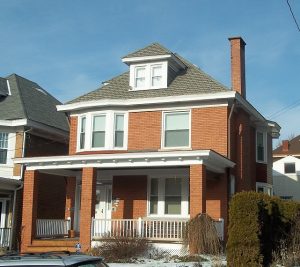
Background:
The homeowner, Rick H. had difficulty keeping his 1920’s three story home warm during the winter time. The walls on his first and second floor were un-insulated, making that portion of the home cold and drafty as well. He also felt his energy bills were much higher than they needed to be. Being an architect, Rick knew that dense pack cellulose was the best solution for wall insulation. Like most customers, he wanted to feel more comfortable in his home, while at the same time improving its energy efficiency.
Energy Efficiency & Comfort Enhancements Completed:
- Air sealed and re-insulated complete 3rd floor. Click here for video on how we do these homes!
- Air sealed the gaps between the floor joists that lie below the knee walls.
- Re-attached and sealed disconnected duct work.
- Re-insulated knee walls with R-19 fiberglass batting & covered with Tyvek paper.
- Dense packed slope ceilings and upper attic with cellulose insulation.
- Insulated floors of lower attic areas with cellulose insulation.
- Weather stripped and insulated access doors with R-10, 2” foam board.
- Dense packed the exterior walls of 1st and 2nd floor with cellulose insulation (R-15).
Home’s Problems & Solutions:
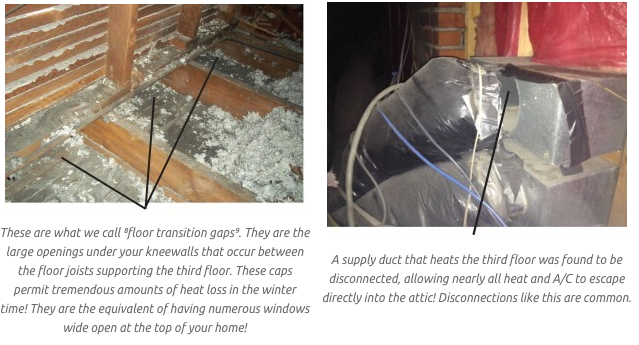
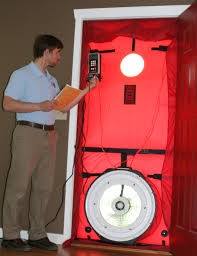 As usual, we performed a free air infiltration test (with a blower door) during our initial visit and also did some infrared imaging. We found that his exterior walls were un-insulated on the first 2 floors, and that his third floor had several problems. Among the issues on his third floor were that the short knee walls and sloped ceilings were poorly insulated, the duct work that heated and cooled the floor was not properly connected, the access doors to the attic spaces were un-insulated and did not seal tightly, and the floor joist gaps under the knee walls were wide open.
As usual, we performed a free air infiltration test (with a blower door) during our initial visit and also did some infrared imaging. We found that his exterior walls were un-insulated on the first 2 floors, and that his third floor had several problems. Among the issues on his third floor were that the short knee walls and sloped ceilings were poorly insulated, the duct work that heated and cooled the floor was not properly connected, the access doors to the attic spaces were un-insulated and did not seal tightly, and the floor joist gaps under the knee walls were wide open.
This last issue is a major cause for energy loss and comfort problems in three story and Cape Cod style homes.
How we Fixed Rick’s Home:
Third Floor
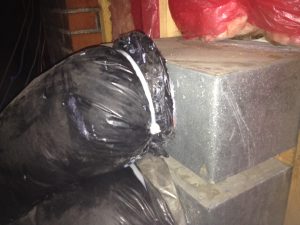 We started on the third floor. The first thing we did was re-connect and seal the damaged duct work that we found. This permitted all of the conditioned air to properly reach his office. We then sealed the gaps between the floor joists (below the knee walls).
We started on the third floor. The first thing we did was re-connect and seal the damaged duct work that we found. This permitted all of the conditioned air to properly reach his office. We then sealed the gaps between the floor joists (below the knee walls).
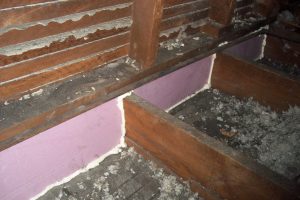
Next up was insulating the knee walls with thick, fluffy batts of R-19 fiberglass insulation and then covering it with Tyvek paper to improve its ability to retain heat.

From there we dense packed the slope ceilings and main upper attic with cellulose insulation. Lastly we insulated the access doors and added weather stripping to them to make them air tight.
First and Second Floors
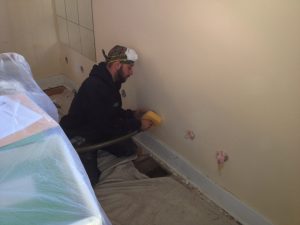 Next we dense packed his exterior walls with cellulose insulation. We drilled one access hole per stud bay (just above the floor), inserted the fill tube all the way up the wall, and then filled each stud bay with cellulose insulation under very high pressure.
Next we dense packed his exterior walls with cellulose insulation. We drilled one access hole per stud bay (just above the floor), inserted the fill tube all the way up the wall, and then filled each stud bay with cellulose insulation under very high pressure.
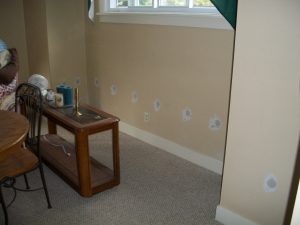
With this process we guarantee your wall insulation will never settle, that it will significantly improve the comfort of your home, and that it will dramatically reduce drafts and air infiltration. Lastly we filled the access holes with non-shrinking, non-cracking plaster.
How about the Results?
Rick was very curious to see the results so he asked us to perform another air infiltration test once we’d finished. The test showed that our air sealing and insulation processes had reduced air infiltration by an impressive 42%! According to Rick, “the work Insulwise performed was like magic. After the first day my house was much quieter and the air conditioner was hardly running at all (he actually wondered whether it had broke)! I couldn’t believe the effect that the air sealing work alone had done!”
I then phoned him back during the winter to see what changes he had noticed. Rick stated, “my wife was shocked to see that the heating bills had gone down by nearly 50% on a monthly basis from the previous winter. The top floor was much warmer, and the drafts that had plagued the lower floors were completely gone!” Rick was more than happy to have us use his home for one of our case studies and include a few quotes from him.
Cost:
We do not include costs for our jobs here because of the many variables involved in pricing each home. We typically estimate a payback time of 2-5 years for most homes that we work on, given the substantial reductions in energy bills that most often result from our work! So call us today for a free energy and comfort analysis of your home!

 Two Story Colonial Home
Two Story Colonial Home 1950’s Ranch Style Home
1950’s Ranch Style Home Two Story Contemporary Home
Two Story Contemporary Home Modern Patio Home
Modern Patio Home Three Story Home
Three Story Home Cape Cod Home
Cape Cod Home Attic Insulation
Attic Insulation Floor Insulation (Garage Ceiling)
Floor Insulation (Garage Ceiling) Wall Insulation
Wall Insulation Basement Insulation
Basement Insulation Air Leak Sealing
Air Leak Sealing